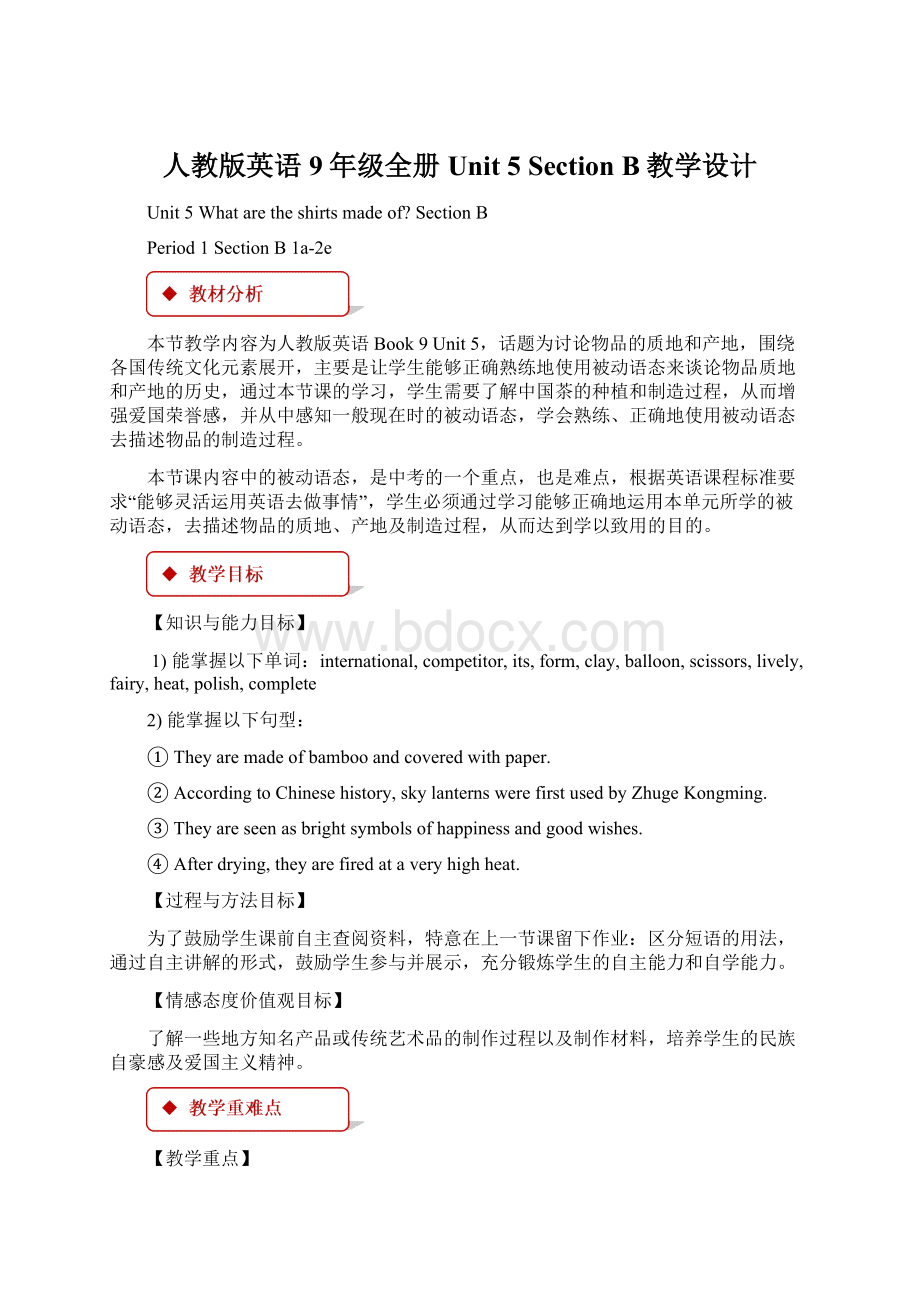人教版英语9年级全册Unit 5 Section B教学设计Word文档下载推荐.docx
《人教版英语9年级全册Unit 5 Section B教学设计Word文档下载推荐.docx》由会员分享,可在线阅读,更多相关《人教版英语9年级全册Unit 5 Section B教学设计Word文档下载推荐.docx(11页珍藏版)》请在冰豆网上搜索。

1.准备录音机和磁带;
2.设计课后巩固练习;
3.ppt;
Step1.Revision
1.Dailygreeting.
2.Review.主动语态变被动语态的方法
Computersareusedtosearchinformation.
Thestoryisoftenrepeatedbytheteacher.
ThecatsarecarefullylookedafterbyBill.
Englishisn’toftenspokenbyusathome.
Step2.Presentation
1.Presentthenewwordsonthebigscreenandlearnthenewwordstogether.
clayn.黏土;
陶土balloonn.气球
scissorsn.剪刀fairytale童话故事
papercutting剪纸celebrationn.庆典;
庆祝活动
internationaladj.国际的
e.g.Thekilogramistheinternationalstandardofweight.
公斤是国际通用的重量标准。
competitorn.参赛者;
竞争者
compete(动词)+or→competitor(名词)
e.g.Wecancompetewiththebestteams.
我们能与最好的队竞争。
Eachcompetitorshouldwearanumber.
每个比赛者必须佩戴一个号码。
formn.形式;
类型
e.g.Joggingisahealthyformofexercise.
慢跑是一种健康的锻炼方式。
itsadj.它的
e.g.Mypetdoglikescatchingbiscuitsinitsmouth.
我的宠物狗喜欢用嘴接饼干。
livelyv.生气勃勃的;
鲜艳的
e.g.Maryisalovelyyoungwomanwithimagination.
玛丽是一名富有想象力生气勃勃的年轻女人。
historicaladj.(有关)历史的
e.g.Thesearenotjusthistoricalpoints.
这可不仅仅是历史的观点。
heatn.热;
高温v.加热;
变热
e.g.Heatthewater,otherwiseitwillfreeze.(动词)
把水加热,否则会结冰。
Theheatfromthefirewillsoondryyourcoat.(名词)
炉火的高温很快就会烘干你的上衣。
polishv.磨光;
修改;
润色
e.g.Let’spolishthesilverbeforetheguestsarrive.
让我们在客人到达前将银器擦亮。
Wouldyoupolishupthearticleabit?
你把文章再润色一下好吗?
completev.完成
completesth.完成某事
completedoingsth.完成做某事
e.g.Theymadeeveryefforttocompletethetask.
他们尽最大努力完成任务。
Theyhavejustcompletedbuildingthebridge.
他们刚刚建成那座大桥。
2.Ssreadandtrytorememberthenewwords.
Step3.Leadin
PresentthepictureandletSstalkabout:
DoyouknowsomethingaboutWeiFangInternationalKiteFestival.
Doyoulikeflyingkites?
Whatkindofkitesdoyouhave?
Step4.Listening
Workon1a
1.Doyouknowhowtoflyakite?
Whatarekitesmadeof?
Writedownsomematerialsusedinmakingkites.
2.LetSsdiscussaboutit.Thenwritedowntheiranswers.
3.Checktheanswerstogether.
bamboo,steel,paper,clothes,cord,knife,scissorsandsoon.
Workon1b:
1.TellSstolistentoaconversationbetweenLauraandZhengYunandcirclethecorrectanswers.
2.PlaytherecordingfortheSs.Ssjustlistenforthefirsttime.Playtherecordingagainandcirclethecorrectanswers.
3.Checktheanswers:
Workon1c:
1.LetSsreadthesentencesin1cfirst.TellSstolistenagainandwriteLforLauraorZforZhengYun.
2.PlaytherecordingagainfortheSstolistenandwritethewords.
3.Sslistentotherecordingcarefullyandtrytowritedowntheiranswers.
4.Checktheanswerswiththeclass.
Workon1d
1.Listenagainandfillintheblankswithwhatyouhear.
2.Sslistenandtrytowritedowntheiranswers.
3.ChecktheanswerswiththeSs.
Step5.Role-play
1.Workinpairs.Role-playaconversationbetweenLauraandZhengYunusingtheinformationin1b-1d.
2.LettwoSsmakeaconversationasamodel:
A:
Wheredidyougoonvacation?
B:
Iwenttoaninternationalkitefestival.
Thatsoundsinteresting.Whatdidyouseethere?
Isawmanydifferentkindsofkitesatthefestival.
Werethekitesnice?
Yes,theywerebeautiful.Theyweremadeofdifferentthingslikesilkorpaper.Somewerepaintedwithcolorfuldrawings.
Soundslikeyoureallyenjoyedit.Ineverthoughtthatsomethingassimpleaskiteflyingcouldbesoexciting.
Yes,itwasreallyfuntoseewhichkitecouldflythehighest.
IthinkIwanttolearntoflyakite,too.
Step6.Production
1.Showsomepicturesofthepapercuttingonthebigscreen.TellSstheyareChinesepapercuttings.It’soneoftheChinesetraditionalarts.
T:
Doyouknowfolkortraditionalarts?
Nowdiscusswithyourpartner.
2.AsksomeSssaywhattheyknowaboutthefolkortraditionalarts.
Step7.Reading
TellSsthefollowingisaboutthreekindsofChinesetraditionalarts.
FastReading:
1.Readthepassageandcompletethechartbelow.
Traditionalartform
Materialsused
2.Checktheanswers.
CarefulReading
Workon2c:
1.T:
Nowlet’sreadthepassageagainandanswersthequestions.
2.LetSsreadthequestionsfirstandmakesuretheyknowthemeaningofeachquestion.
3.Ssreadthepassageandanswertheirquestions.
Workon2d:
1.LetonestudentreadthephrasesintheboxandtranslatethemintoChinese.
2.Ssreadthesentencesandcompletethesentencesusingthecorrectformsofthephrasesinthebox.
sendout;
riseinto;
turns,into;
puton;
suchas;
coveredwith
Step8.Languagepoints
1.Theseusuallytrytoshowthethingsthatareimportantinlife,suchaslove,beautyandfamily.
suchas和forexample都有“例如”的意思,但是它们的用法有所不同。
★suchas常用来列举同类人或事物中的多个例子。
e.g.Ilikeanimals,suchasdogs,catsandmonkeys.
我喜欢动物,如狗、猫和猴子。
★forexample一般只以同类人或事物中的“一个”为例。
e.g.Hehaseverbeentomanycountries,forexample,Australia.
他曾经去过许多国家,如澳大利亚。
2.Themostcommonthings,frompapertoclaytobamboo,areturnedinto
objectsofbeauty.
1)turn…into…表示“把……变成……;
使……变成……”
,而turninto表示“转变;
变成”等意思。
e.g.Canyouturnaneggintoaflower?
你能把鸡蛋变成花朵吗?
Thesunnymorningturnedintoarainyday.
晴朗的早晨变成了雨天。
2)objectsofbeauty在此为“精美植物;
精美物品”的意思。
其中object指具体、实际的“物品;
东西”。
e.g.Look,there’sastrangeobjectinthesky!
快瞧,天上有一个奇怪的东西。
3.AccordingtoChinesehistory,skylanternswerefirstusedbyZhugeKongming.
accordingto根据,按照;
据……所说
e.g.Accordingtotheradio,itwillraintomorrow.
据电台广播,明天有雨。
4.Thepiecesarecarefullyshapedbyhandfromaveryspecialkindofclayandthenallowedtoair-dry.
1)此句中名词piece意为“作品”,指由艺人、作家等创作出来的艺术品或
文学作品。
如:
Justtakealookatthislovelyclaypiece.Doesn’tthisboylookreal!
看看这个可爱的小陶人,这男孩看上去多么逼真啊!
Didyoureadthatpieceintoday’snewspaper?
你看过今天报纸上的那片文章了吗?
2)air-dry是由air和dry复合而成的一个合成动词,意为“晾干”,类似的词还有blow-dry吹干。
5.Ittakesseveralweekstocompleteeverything.
Ittakes(sb.)sometimetodosth.是英语中的常用句型,意为“花费(某人)多长时间做某事”。
其中it是形式主语,动词不定式(短语)是真正的主语。
e.g.IttookJackthreehourstomakethemodelplane.
杰克做这个飞机模型花了三个小时。
Step9.Groupwork
Workon2e
1.Nowlet’sworkon2e.Firstreadthequestionsbelow.Thentrytodiscussthequestionsinyourgroup.
Whichartformdoyouthinkistheeasiest?
Whichisthemostdifficult?
Why?
Whichartformwouldyouliketolearn?
Why?
2.LetsomeSsreadtheiranswers.
Step10.Homework
1.Readthepassageagainafterschool.
2.TrytowriteashortintroductiononhowtomakeaChineseclaypiece.
略
Period2SectionB3a-SelfCheck
1)复习被动语态的不同用法。
2)能够用英语描述一些常用生活用品的制作材料;
描述一些熟悉物品的制作过程。
3)能用就本单元所学习的语法知识及语言材料,就自己所熟悉的话题写一篇小作文。
介绍自己家乡的某个较为著名的艺术品、食物、工商产品等。
在教学过程中,使用说读等形式对教材的语料对学生进行语料输入,增强学生对相关语料的熟悉程度和语感,进而增强学生对相关语料的驾驭和变通利用能力,比如模仿相关句式,时态,思路等。
了解一些日常用品的制成材料,增加生活常识,养成良好的生活习惯;
1)能运用本单元所学的语法及语言材料,完成写作介绍自己熟悉的物品的制件材料及过程。
2)掌握本单元所学被动语态这一语法知识点,并能运用这一知识进行造句。
3)能总结本单元所学的物质材料、及一些艺术品的简单制作过程。
阅读短文,完成写作。
Reviewthemainphrasesandsentences.
Step2.Talking
AsksomeSstodescribehowtomakeaChineseclaypiece.
Ø
First,thepiecesarecarefullyshapedbyhandfromaveryspecialkindofclayandthenallowedtoair-dry.
Second,afterdrying,theyarefiredataveryhighheat.
Atlast,theyarepolishedandpainted.
Step3.Discussion
Talkaboutsomespecialthingsthatyourcityisfamousfor.
e.g.
A:
What’syourcityfamousfor?
B:
Ourcityisfamousformakinglanterns.
Really!
Whataretheymadeof?
They’remadeofbamboo,silkorpaper.
Whattheycando?
Theywerefirstusedforlightingintheolddays.Today,theyareusedatfestivalsandothercelebrations.
Whyaretheyspecial?
Chinesepeoplelovelanternsverymuchbecausethey’resymbolsofgoodluckandfamilyreunion(团圆).
Step4.Writing
1.Workon3a.
Whataresomespecialthingsthatyourtown/cityisfamousfor?
Thesecanbefood,artworkoranyotherproducts.Discussthemwithapartnerandtakenotes.
2.Workon3b.
Writeaparagraphabouttheproduct.Useyournotesin3a.
1.Usethefollowingexpressionstohelpyou:
Mytown/cityisfamousfor…
…isfamousinmytown/city.
…is/aremadeof/from/with/by/in…
…is/areusedfor…
…is/areknownfor…
…is/arespecialbecause…
2.写作指导:
这是一篇科普性说明文,让同学们介绍灯笼的相关情况,语态应为被动语态为主;
时态应以一般现在时为主,辅以少量一般过去时态或其他时态的句子。
写作时,应理清自己的写作思路,逐条清晰地进行介绍。
比如,可以先介绍灯笼的历史、用途及象征意义。
然后介绍人们悬挂灯笼的时间。
最后,介绍灯笼的制作材料、产地及其类型。
注意要恰当运用被动语态,检查被动语态句的数、时态以及句子结构等是否正确。
3.Ss